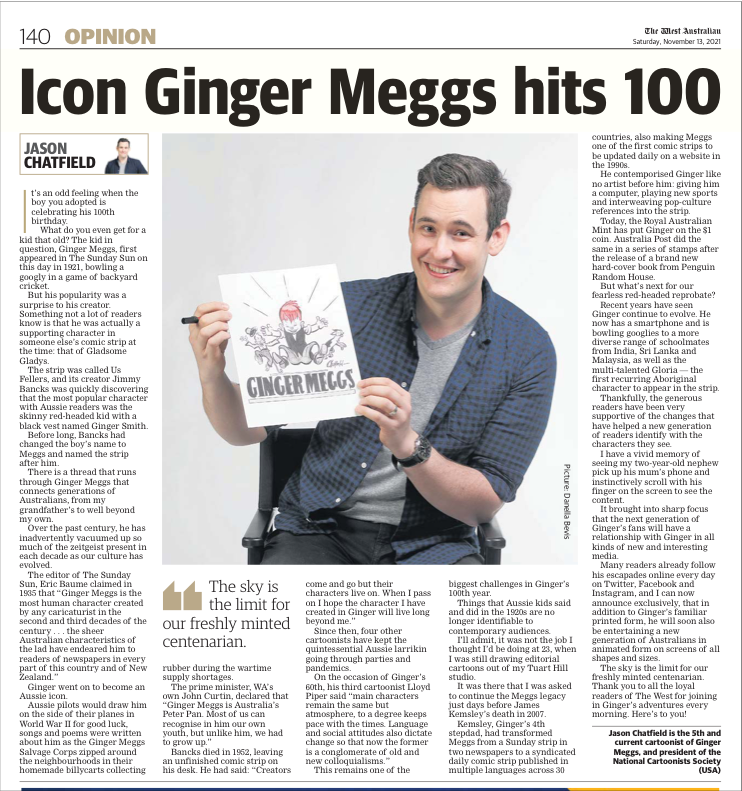Australian Icon Hits 100 - Published in The West Australian
Lovable Larrikin Ginger Meggs Reaches a Milestone
Ginger went on to become an Aussie icon.
Aussie pilots would draw him on the side of their planes in World War II for good luck, songs and poems were written about him as the Ginger Meggs Salvage Corps zipped around the neighbourhoods in their homemade billycarts collecting rubber during the wartime supply shortages.
The prime minister, WA’s own John Curtin, declared that “Ginger Meggs is Australia’s Peter Pan. Most of us can recognise in him our own youth, but unlike him, we had to grow up.”
Bancks died in 1952, leaving an unfinished comic strip on his desk. He had said: “Creators come and go but their characters live on. When I pass on I hope the character I have created in Ginger will live long beyond me.”
Since then, four other cartoonists have kept the quintessential Aussie larrikin going through parties and pandemics.
On the occasion of Ginger’s 60th, his third cartoonist Lloyd Piper said “main characters remain the same but atmosphere, to a degree keeps pace with the times. Language and social attitudes also dictate change so that now the former is a conglomerate of old and new colloquialisms.”
This remains one of the biggest challenges in Ginger’s 100th year.
Things that Aussie kids said and did in the 1920s are no longer identifiable to contemporary audiences.
13th November, 2021
The West Australian - Page 44
It’s an odd feeling when the boy you adopted is celebrating his 100th birthday. What do you even get for a kid that old? The kid in question, Ginger Meggs, first appeared in The Sunday Sun on this day in 1921, bowling a googly in a game of backyard cricket.
But his popularity was a surprise to his creator. Something not a lot of readers know is that he was actually a supporting character in someone else’s comic strip at the time: that of Gladsome Gladys.
The strip was called Us Fellers, and its creator Jimmy Bancks was quickly discovering that the most popular character with Aussie readers was the skinny red-headed kid with a black vest named Ginger Smith.
Before long, Bancks had changed the boy’s name to Meggs and named the strip after him.
There is a thread that runs through Ginger Meggs that connects generations of Australians, from my grandfather’s to well beyond my own.
Over the past century, he has inadvertently vacuumed up so much of the zeitgeist present in each decade as our culture has evolved.
The editor of The Sunday Sun, Eric Baume claimed in 1935 that “Ginger Meggs is the most human character created by any caricaturist in the second and third decades of the century . . . the sheer Australian characteristics of the lad have endeared him to readers of newspapers in every part of this country and of New Zealand.”
Thankfully, the generous readers have been very supportive of the changes that have helped a new generation of readers identify with the characters they see.
I have a vivid memory of seeing my two-year-old nephew pick up his mum’s phone and instinctively scroll with his finger on the screen to see the content.
It brought into sharp focus that the next generation of Ginger’s fans will have a relationship with Ginger in all kinds of new and interesting media.
Many readers already follow his escapades online every day on Twitter, Facebook and Instagram, and I can now announce exclusively, that in addition to Ginger’s familiar printed form, he will soon also be entertaining a new generation of Australians in animated form on screens of all shapes and sizes.
The sky is the limit for our freshly minted centenarian. Thank you to all the loyal readers of The West for joining in Ginger’s adventures every morning.
Here’s to you!
_
Jason Chatfield is the 5th and current cartoonist of Ginger Meggs, and president of the National Cartoonists Society (USA)
Copyright © 2021 The West Australian
I’ll admit, it was not the job I thought I’d be doing at 23 when I was still drawing editorial cartoons out of my Tuart Hill studio.
It was there that I was asked to continue the Meggs legacy just days before James Kemsley’s death in 2007.
Kemsley, Ginger’s 4th stepdad, had transformed Meggs from a Sunday strip in two newspapers to a syndicated daily comic strip published in multiple languages across 30 countries, also making Meggs one of the first comic strips to be updated daily on a website in the 1990s.
He contemporised Ginger like no artist before him: giving him a computer, playing new sports and interweaving pop-culture references into the strip.
Today, the Royal Australian Mint has put Ginger on the $1 coin. Australia Post did the same in a series of stamps after the release of a brand new hard-cover book from Penguin Random House.
But what’s next for our fearless red-headed reprobate?
Recent years have seen Ginger continue to evolve. He now has a smartphone and is bowling googlies to a more diverse range of schoolmates from India, Sri Lanka and Malaysia, as well as the multi-talented Gloria — the first recurring Aboriginal character to appear in the strip.

